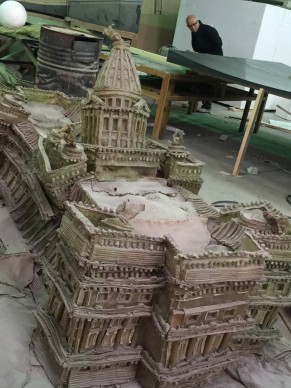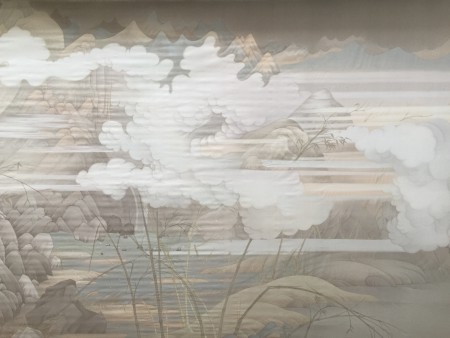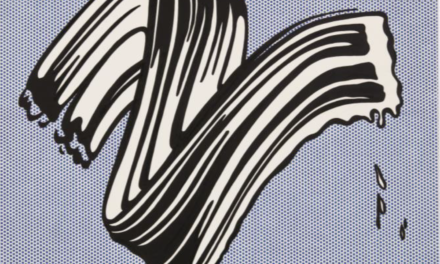Located outside of Shanghai, megalomaniac artist Zhang Huan was the star of the Western art market a few years ago. He employed more than 100 people in his factory-studio. Evidently, today, productivity is down, and helping hands noticeably less numerous. The artist’s work is polymorphous and tends to come in very, very large formats. He flooded collections with his “ashes paintings,” figurative pastels in black and white made of ashes found in Buddhist temples and representing landscapes or portraits. In his studio, you come across a wrecked train he salvaged after an earthquake in Sichuan, a gigantic silicone head of Confucius animated by a mechanism that gives the illusion it’s breathing and an outdoor cage containing his monkey collection. “Looking at monkeys is like looking at your life.”
The artist spent 8 years in the U.S. and is happy about being back. “In China I had the opportunity to give form to the ideas I’d had in New York. I hold my Chinese identity dear. My success in the art market is less important.” His dream now, at 50, is to make a movie.
“A mix of fiction and fantasies in Tibet, about life after death. Today my work finds support outside China, but after my death it will be supported in China. Here people have held on to the idea of my first performances and they wonder whether they’re art.” Zhang Huan talks about contemporary China: “Even if there are good and bad traditions, people here don’t have any reference points anymore. They have no faith at all. They are lost. Personally I believe in all human gods as long as they’re good.” The artist goes on about the idea that we’ve all already had several lives and concludes: “We’re all the living dead.” Zang Huan has become the biggest collector of Chinese tombs. He buys them from small farmers – which is taboo in this country.
In Shanghai still, I met with Xu Zhen, who gathered a consortium of artists under the umbrella name MadIn until he reverted to his own name in 2013. In the studio’s glacial 5,000 square meters [53,800 square feet], the young man keeps me waiting. He’s the brain behind some 30 artists who execute his ideas. He works around the theme of irony, of appropriation and of the distortion of clichés. He twists the necks of copies of Ming ceramics to the point where they become anthropomorphic-looking. He makes large garish tapestries that compile stereotypes of Chinese popular culture, from tigers to dragons; copies of antique Western sculptures topped with copies of antique Chinese sculptures; as well as bodies of gods or athletes topped with antique Buddha bodies. All of them headless, and here’s the symbol. Says the artist, “Since I was very small, I wanted to become an artist. I studied graphic design by error but in the end it was for the best. Abstraction, figuration, sculpture, painting—all this isn’t important.” He continues: “Today China is prey to an East/West culture shock, but our environment is stimulating in terms of art creation. In Chinese, madin means, ‘Who doesn’t have a roof.’ We have no limits.’” Xu Zhen explains that he’s had a phobia about planes since 2005 and therefore doesn’t travel. “I refuse this type of circus as an artist.” Yet he concludes: “The artist is a brand. Therefore art shouldn’t be such a personal thing anymore. We need to reform art management. Today I’m spending more time managing my company than being creative. Because finding ideas is something that is done fast. You know, it’s people like me who are sincere.”
In Beijing, the artist Liu Wei is also presenting polymorphous work. A group of journalists is visiting his studio, and he really hates the experience. He’s not answering questions. He’s blocked. His best-known and most lucrative work consists of multicolor paintings conceived on a computer, then executed on canvas by his assistants: abstract representations such as schematic skyscraper shapes seen through a bright multicolor prism of pollution, rainbow or—who knows?—sunset. He also builds immense translucent towns out of cattle skin. He’s an artist entrepreneur. His studio is scheduled for destruction sometime soon, as is the rest of his neighborhood. Finally he says: “Destruction is a system. Here, that’s the way it’s been since I was born. Everyone is nostalgic and afraid of the future. China is caught in a process of perpetual evolution.”
Finally, one of this trip’s most surprising encounters is with the young artist Hao Liang, born in 1983, who is attempting to re-appropriate a culture that the Cultural Revolution sought to power-steam away. “I’ve been interested in Chinese traditional painting every since I was very small. My training hasn’t been that of a classical artist. In fact, I feel closer to the world of scholars. I am steeped in the history of Chinese art. Traditionally, there’s been no relationship between art and society in China. But after 1949, realism became the dominant trend. And now in our generation, there’s a real fascination with the past. We’re not interested in art that is useful. However, there’s spirituality here. My quest consists in finding some kind of modernity in tradition. During the Song Dynasty, people looked at nature in detail. During the Ming Dynasty, people had a more intellectual approach. I am synthesizing the two. In this approach, form and medium are essential.” Ink paintings, 15-meter [49-foot] scrolls, precise gestures, delicate Pointillist figuration. Hao Liang creates sophisticated compositions mixing the contemporary and the old in a completely traditional manner—by himself. He recounts how one of his paintings about antique gardens took two and a half years to research and six months to make. He concludes: “Tradition is in the air.”
Twenty-first century China is rich, heterogeneous and paradoxical, just like some of its artists.
Donating=Supporting

Support independent news on art.
Your contribution : Make a monthly commitment to support JB Reports or a one off contribution as and when you feel like it. Choose the option that suits you best.
Need to cancel a recurring donation? Please go here.
The donation is considered to be a subscription for a fee set by the donor and for a duration also set by the donor.















